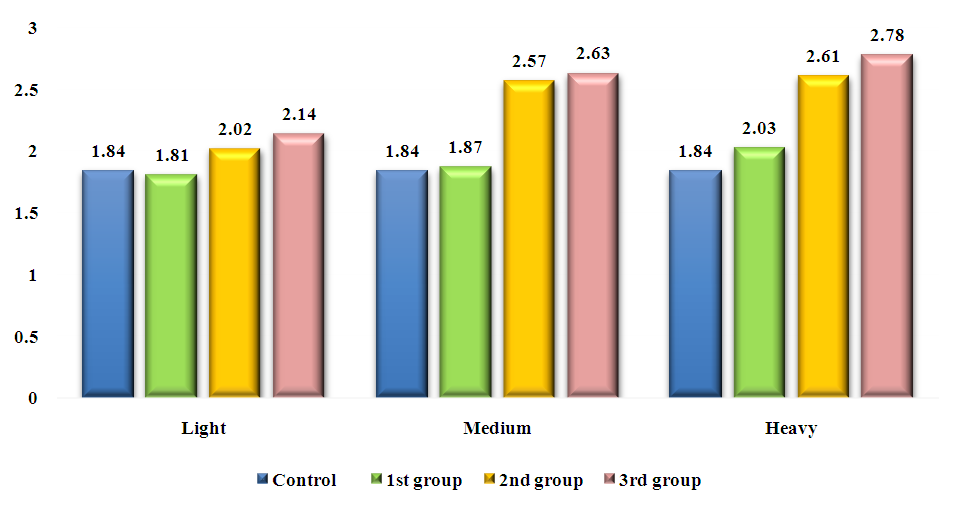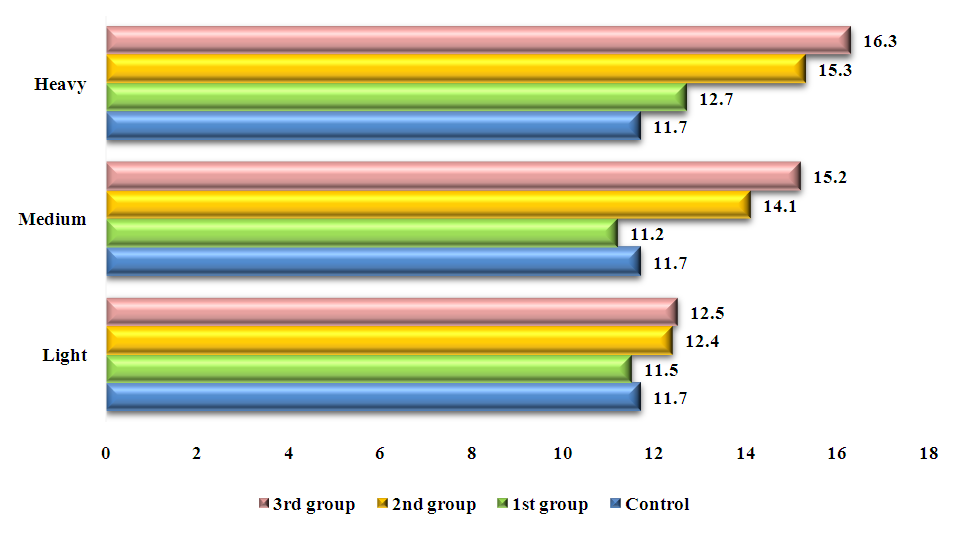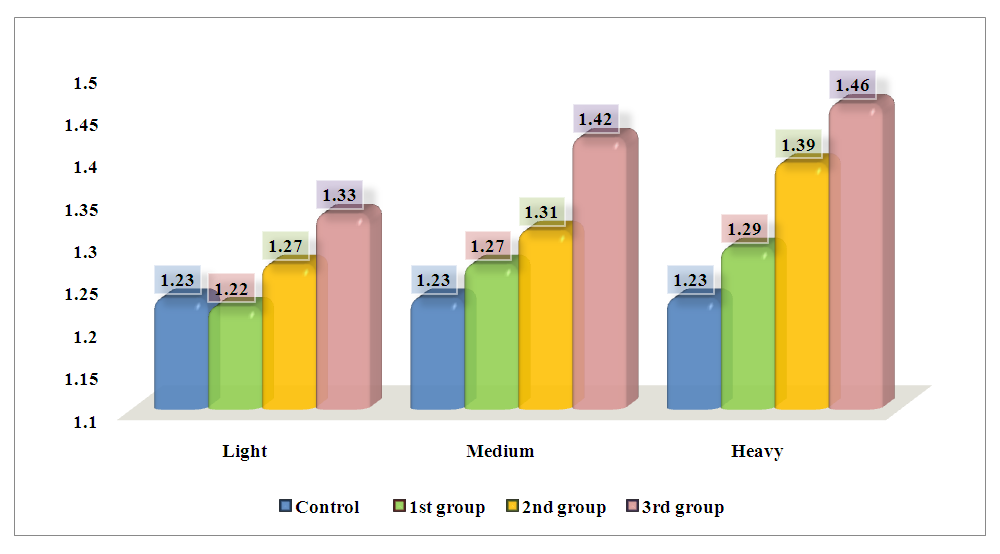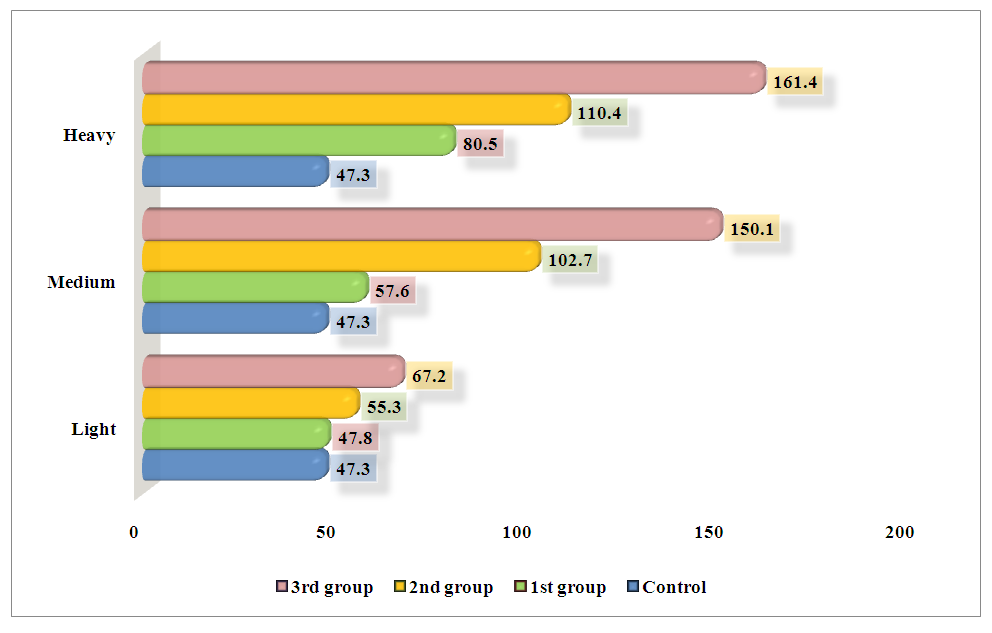Badriddinov A. S.1, Khamdamov B. Z.1, Askarov T. A.2
1Bukhara State Medical Institute, Uzbekistan
2Tashkent Medical Pediatric Institute, Uzbekistan
Correspondence to: Khamdamov B. Z., Bukhara State Medical Institute, Uzbekistan.
| Email: |  |
Copyright © 2025 The Author(s). Published by Scientific & Academic Publishing.
This work is licensed under the Creative Commons Attribution International License (CC BY).
http://creativecommons.org/licenses/by/4.0/

Abstract
The article analyzes the role of humoral immunity in the pathogenesis of impaired bone regeneration in patients with long bone fractures after COVID-19. A total of 126 patients were examined, divided into three groups according to the type of fracture consolidation: normal, delayed, and delayed with complications. Serum levels of immunoglobulins A, G, M, and E were measured by ELISA and compared depending on the severity of COVID-19. The results showed a significant increase in IgA, IgG, IgM, and especially IgE levels in groups with impaired consolidation, most notably after severe COVID-19. These changes are associated with persistent immune activation and possible autoimmune or allergic-type inflammation that can inhibit bone healing. Immunoglobulin levels may serve as early predictive markers of complicated post-COVID bone healing.
Keywords:
Post-COVID, Humoral immunity, Immunoglobulins, Bone regeneration, Delayed consolidation, Long bones, Fracture healing
Cite this paper: Badriddinov A. S., Khamdamov B. Z., Askarov T. A., Changes in the Humoral Immune Response in Patients with Different Types of Fracture Consolidation After COVID-19, American Journal of Medicine and Medical Sciences, Vol. 15 No. 7, 2025, pp. 2364-2369. doi: 10.5923/j.ajmms.20251507.58.
1. Introduction
The COVID-19 pandemic has led to a significant increase in the number of patients with post-viral complications. Particular attention is drawn to cases of delayed and complicated fracture consolidation in patients who have had the infection and previously had no signs of osteopathy [1,5,13,15,17,19,26]. Current data indicate a pronounced and long-term impact of SARS-CoV-2 on the immune system, including the formation of chronic inflammation and autoimmune reactions [3,7,11,14,16,18,20]. Immunological mechanisms play a key role in the regulation of osteogenesis, and their imbalance can have a direct impact on bone healing. Identification of immunological markers associated with delayed consolidation will allow a deeper understanding of the pathogenesis of these conditions and the formation of immunologically based approaches to diagnosis and therapy [2,4,9,21,22]. It is especially important to determine predictors of complicated course in patients with a high risk of immune response dysregulation. A comprehensive immunological assessment can form the basis for a personalized approach to the management of post-COVID patients with fractures [5,8,11,23,24]. In this regard, the study of immunological markers of delayed consolidation in patients who have had COVID-19 is a highly relevant area of modern medicine [6,8,10,25].Currently, more and more attention is paid to the role of the humoral component of the immune system in bone tissue regeneration processes. Immunoglobulins, being key components of the systemic immune response, are involved not only in anti-infective protection, but also in the modulation of inflammation, osteogenesis and angiogenesis. This is especially important in patients who have had COVID-19, who are characterized by long-term persistence of immune and inflammatory disorders, which can affect reparative processes [9,12].An imbalance between different classes of immunoglobulins can reflect the presence of systemic activation of the immune system, autoimmune shifts, as well as a tendency to chronic inflammation, which can potentially slow down fracture consolidation.Purpose of the study: To determine the characteristics of changes in the levels of the main classes of immunoglobulins depending on the form of consolidation of the fracture of long tubular bones and the severity of COVID-19.
2. Materials and Methods of Research
Based on the above, 126 patients with fractures of long tubular bones who had COVID-19 in the period 2022-2024 and applied to the Bukhra Regional Multidisciplinary Medical Center were examined to identify immunological markers of impaired bone tissue reparation. Depending on the nature of the course of the reparative process, all patients were divided into three groups: Group 1 included 28 patients without signs of delayed consolidation; Group 2 - 65 patients with delayed consolidation; Group 3 - 33 patients with delayed consolidation complicated by inflammatory and / or destructive changes in the fracture zone. Additionally, all three groups were stratified by the severity of COVID-19.According to anamnestic data, 11 patients in group 1 had a mild form of COVID-19, 11 had a moderate form, and 6 had a severe form. In group 2, there were 24 patients with a mild form of the disease, 26 with a moderate form, and 15 with a severe form. In group 3, 8 patients had a mild form, 15 had a moderate form, and 10 had a severe form.Determination of serum immunoglobulins A, G, M, E was performed using enzyme-linked immunosorbent assay (Xema).Statistical processing of data was carried out using SPSS 22.0 and Statistica 10.0 programs. Differences were considered statistically significant at p < 0.05.
3. Study Results
IgA, as a key component of mucosal and systemic immunity, can participate in the pathogenesis of bone remodeling disorders by mediating the activation of proinflammatory cytokines and interacting with receptors of immune cells and bone tissue cells (in particular osteoclasts) [3,7].The obtained data demonstrate a clear tendency for the IgA level to increase depending on the severity of bone reparation disorders. In the mild form of COVID-19, the differences between the control group (1.84 ± 0.12 g/l) and the 1st group (1.81 ± 0.15 g/l) were minimal and statistically insignificant. However, already in the 2nd group (2.02 ± 0.18 g/l), where delayed consolidation without complications was noted, the IgA level increased by 1.1 times compared to the control, and in the 3rd group - up to 2.14 ± 0.17 g/l, that is, almost 1.2 times.The differences between the groups, depending on the severity of COVID-19, became even more pronounced. In the moderate course of the disease, the IgA level in the 2nd group (2.57 ± 0.21 g / l) was almost 1.4 times higher than the control, and in the 3rd group (2.63 ± 0.24 g / l) - 1.43 times. The most significant increase was observed in the severe course of COVID-19: the IgA level in the 2nd group reached 2.61 ± 0.23 g / l (1.42 times higher than the control), and in the 3rd - 2.78 ± 0.26 g / l (1.5 times higher; p < 0.05) (Fig. 1). | Figure 1. Levels immunoglobulin A in those examined patients (g/l), (P ≤ 0.05) |
An increase in the IgA level reliably correlates with an increase in bone tissue reparative disorders after COVID-19. This may reflect chronic inflammatory activation that persists after an infection, especially in patients with complicated delayed consolidation. Given the identified patterns, the IgA level can be considered as a potential biomarker of the risk of delayed and complicated consolidation in patients who have had COVID-19. Its dynamics deserve close study both in the clinical aspect and from the standpoint of pathophysiological mechanisms underlying post-COVID regeneration disorders.Immunoglobulin G, being the main representative of humoral immunity, forms a long-term immune response and is able to interact with Fc receptors on immune and bone cells, including osteoclasts, potentiating bone resorption. It is also known that excessive or prolonged synthesis of IgG can be accompanied by a violation of inflammation regulation, microvascular changes and tissue trophic disorders, which is critically important in the phases of bone tissue restoration [2,6].The obtained data demonstrate a natural increase in the IgG level as the clinical picture worsens, both in terms of the severity of COVID-19 and the nature of subsequent bone regeneration. In the mild form of the disease, the differences between the groups were minimal: in the control group, the indicator was 11.7 ± 0.84 g / l, in the 1st group - 11.5 ± 0.71 g / l, in the 2nd - 12.4 ± 0.92 g / l, in the 3rd - 12.5 ± 1.01 g / l. Despite a slight increase in the 2nd and 3rd groups (1.06-1.07 times compared to the control), the differences were statistically insignificant.More pronounced changes were observed in moderate COVID-19. In group 1, the IgG level was 11.2 ± 0.72 g/l, not significantly different from the control values. However, in group 2, IgG increased to 14.1 ± 1.12 g/l, which is almost 1.2 times higher than the control values, and in group 3 it reached 15.2 ± 1.33 g/l, which corresponds to a 1.3-fold increase. The maximum IgG values were recorded in patients with severe COVID-19. In group 1, the level was 12.7 ± 0.93 g/l, slightly exceeding the control. In the 2nd group, it increased to 15.3 ± 1.22 g/l — 1.3 times higher, and in the 3rd — to 16.3 ± 1.41 g/l, which is 1.4 times higher than the level of healthy individuals (Fig. 2). As can be seen from the data obtained, there is a progressive increase in the IgG level in patients with impaired consolidation, especially in the presence of complications and severe COVID-19. These data suggest that IgG can act as not only a marker of past infection, but also a marker of chronic immune activation accompanied by inflammation, which can negatively affect the processes of osteogenesis and bone tissue remodeling. The study of the IgG level in patients with post-COVID bone consolidation disorders seems justified and important from the point of view of prognostic assessment of the risk of complicated reparative processes. The inclusion of this marker in a comprehensive examination allows for a deeper understanding of the pathogenesis of post-COVID conditions and may become the basis for the development of immunomodulatory approaches to the treatment of impaired bone regeneration. | Figure 2. Levelsimmunoglobulin G in examined patients (g/l) |
 | Figure 3. Levelsimmunoglobulin M in the examined patients (g/l) |
Immunoglobulin M is the first class of antibodies that is synthesized in response to infection. Its elevated levels in the late period after COVID-19 may reflect not only the residual antigen load, but also a violation of immune regulation with the formation of a protracted or dysregulated inflammatory response. It is known that IgM is able to activate complement and mediate the production of proinflammatory cytokines, contributing to increased inflammation in bone tissue, which can negatively affect the processes of its remodeling and consolidation [4,9].The results of the study demonstrate a gradual increase in IgM levels in patients with impaired bone consolidation, especially in the presence of complicated course. In mild cases of COVID-19, the differences between the groups did not reach statistical significance: the IgM level was 1.23 ± 0.09 g / l in the control group, 1.22 ± 0.08 g / l in group 1, 1.27 ± 0.10 g / l in group 2 and 1.33 ± 0.11 g / l in group 3. A slight increase in group 3 (1.08 times compared to the control) may reflect the initial signs of immune activation in the context of impaired bone tissue reparation.In moderate cases of infection, the differences became more pronounced: in group 1, the IgM level reached 1.27 ± 0.09 g / l (comparable with the control), in group 2 - 1.31 ± 0.11 g / l (1.06 times higher), and in group 3 - 1.42 ± 0.13 g / l, which was 1.15 times higher than the values of healthy individuals. In severe COVID-19, a further increase in indicators was noted: the IgM level in group 2 was 1.39 ± 0.12 g / l, which is 1.13 times higher than the control, and in group 3 it reached 1.46 ± 0.14 g / l, exceeding the norm by 1.19 times. The differences between groups 1 and 3 in severe cases of the disease were statistically significant, which may indicate the role of IgM as one of the early markers of immune dysfunction in impaired bone reparation. Based on the above, the most pronounced increase in IgM levels was noted in patients with delayed consolidation, especially in the presence of complications, and in moderate and severe forms of coronavirus infection. This marker reflects the phase of acute and subacute immune activation, characteristic of the early humoral response, and its persistent increase may indicate the presence of a chronic inflammatory process or incomplete elimination of antigenic stimuli. This marker may be useful as an additional criterion for risk stratification of delayed or complicated consolidation and may help identify patients with prolonged inflammation requiring additional immunomodulatory or anti-inflammatory treatment. | Figure 4. Levels immunoglobulin E in those examined patients (IU/ml) (P ≤ 0.05) |
Immunoglobulin E is traditionally associated with allergic reactions and parasitic infections, but its role in post-infectious and post-inflammatory processes, including reparative disorders, is increasingly being studied. Increased IgE levels in patients with delayed and complicated consolidation may indicate disturbances in the regulation of the immune response, activation of the Th2 component of immunity, and a chronic inflammatory process that interferes with normal osteogenesis [2,4].The obtained data indicate a progressive increase in the IgE level as the course of COVID-19 and the degree of bone consolidation disorders worsen. In the mild form of the disease, the IgE concentration in the control group was 47.3 ± 3.42 IU/ml. In the 1st group, the indicator was at a similar level - 47.8 ± 3.61 IU/ml, while in the 2nd group it increased to 55.3 ± 4.11 IU/ml (1.2 times higher than the control), and in the 3rd - to 67.2 ± 4.83 IU/ml (1.42 times higher). Against the background of moderate COVID-19, the differences became more pronounced: in the 1st group, the IgE level was 57.6 ± 4.72 IU/ml (1.2 times higher than the control), in the 2nd - 102.7 ± 6.91 IU/ml (2.17 times higher (p < 0.05), and in the 3rd - 150.1 ± 9.42 IU/ml, which was 3.17 times higher than the control values (p < 0.05). Statistical significance of the differences was established between the control group and the 2nd and 3rd groups, as well as between the 1st and 3rd groups (p < 0.05).The most pronounced activation of the humoral immune response was observed in patients with severe COVID-19. In group 1, the IgE level was 80.5 ± 5.62 IU/ml (1.7 times higher than the control), in group 2 - 110.4 ± 7.32 IU/ml (2.3 times higher), and in group 3 - 161.4 ± 9.82 IU/ml, which was 3.4 times higher than the control values (p < 0.05). Reliable differences were found between group 3 and all other groups (p < 0.01), which reflects the pronounced activation of the Th2 component of the immune response, characteristic of chronic inflammation and impaired reparation. An increase in IgE levels indicates the possible involvement of allergy-like and autoimmune mechanisms in the pathogenesis of delayed consolidation, especially in the context of post-COVID immune imbalance. Increased IgE production may be associated with the persistence of viral antigens, dysregulated cytokines, and a predominance of the Th2 response, which in turn disrupts the balance of inflammation and bone tissue regeneration. Also, the mechanism of such an increase may be associated with hyperreactivity of the immune system after severe viral infection, activation of mast cells, and increased production of cytokines that promote degradation of the intercellular matrix and inhibition of bone regeneration processes. In addition, IgE mediates the release of inflammatory mediators such as histamine, which impair microvascular perfusion and can contribute to hypoxic changes in bone tissue. IgE is of interest as a potential marker of an unfavorable course of post-COVID bone consolidation. Its significant increase in patients with complicated bone tissue regeneration can serve as a predictor of persistent inflammation and impaired osteoremodeling. Given these observations, it is advisable to include IgE in the diagnostic and prognostic algorithm for assessing reparative processes in patients after COVID-19, especially in the risk group for the development of complicated bone consolidation.
4. Conclusions
Analysis of the humoral component of the immune system in patients with different variants of post-COVID bone reparation revealed significant changes in the levels of all studied immunoglobulins - IgA, IgG, IgM and IgE. The IgA level demonstrated a progressive increase as the clinical picture worsened, especially in groups with delayed consolidation and complications, which may indicate chronic activation of the immune system. IgG reflected the accumulated adaptive immune response and also increased in the presence of reparation disorders, especially in severe cases of COVID-19. IgM concentrations indicated the persistence of inflammatory activity, especially pronounced in patients with severe forms of the disease and concomitant regeneration disorders. The most significant differences were found in IgE, the level of which was many times higher than the control values in patients with severe infection and complicated consolidation, indicating a possible role of allergic-like or autoimmune reactions in the pathogenesis of impaired bone regeneration. The data obtained emphasize the importance of comprehensive immunological monitoring in patients who have had COVID-19 for timely assessment of the risks of delayed bone tissue restoration.
References
| [1] | ARDS Definition Task Force, Ranieri VM, Rubenfeld GD, Thompson BT et al. Acute respiratory distress syndrome: the Berlin Definition // JAMA. 2012. Т. 307, № 23. С. 2526-2533. |
| [2] | Becker, R.C. COVID 19 update: Covid 19 associated coagulopathy // J Thromb Thrombolysis. 2020. Vol. 50. P. 54–67. |
| [3] | Cannada L.K. Dealing with catastrophic outcomes and amputations in the mangled limb. / L.K. Cannada, D.H. Melton, M.E. Deren, R.A. Hayda, E.J. Harvey // J Orthop Trauma. - 2019. - Vol. 29, №12. - P. 39-42. |
| [4] | Channappanavar R., Perlman S. Pathogenic human coronavirus infections: Causes and consequences of cytokine storm and immunopathology // Semin. Immunopathol. 2023. Т. 39. С. 529-539. |
| [5] | Khamdamov I.B. Improving tactical approaches in the treatment of hernias of the anterior abdominal wall in women of fertile age // New day in medicine. Bukhara, 2022. - №10(48) - Р. 338-342. |
| [6] | Khamdamov I.B. Morphofunctional features of the abdominal press in women of reproductive age // New day in medicine. Bukhara, 2022. -№3(41) - Р. 223-227. |
| [7] | Khamdamova M.T., Akramova D. E. Genetic aspects of genital prolapse in women of reproductive age // New day in medicine. Bukhara, 2023. - No. 5 (55). - Р. 638-643. |
| [8] | Khamdamova M.T., Akramova D. E. Genetic aspects of genital prolapse in women of reproductive age // New day in medicine. Bukhara, 2023. - No. 5 (55). - Р. 638-643. |
| [9] | Khamdamova M.T., Teshaev Sh.Zh., Hikmatova M.F. Morphological changes of the thymus and spleen in renal failure in rats and correction with pomegranate seed oil // New day in medicine. Bukhara, 2024. - N. 3(65). - Р. 167-187. |
| [10] | Khamdamova M.T., Khasanova M.T. Various mechanisms of pathogenesis of endometrial hyperplasia in postmenopausal women (literature review) // New day in medicine. Bukhara. 2023. - No. 8 (58). - Р. 103-107. |
| [11] | Khamdamova M.T., Zhaloldinova M.M., Khamdamov I.B. The state of nitric oxide in blood serum in patients with cutaneous leishmaniasis // New day in medicine. Bukhara, 2023. - No. 5 (55). - Р. 638-643. |
| [12] | Khamdamova M.T., Zhaloldinova M.M., Khamdamov I.B. The value of ceruloplasmin and copper in blood serum in women wearing copper-containing intrauterine device // New day in medicine. Bukhara, 2023. - No. 6 (56). - Р. 2-7. |
| [13] | Khamdamov I.B. Improving tactical approaches in the treatment of hernias of the anterior abdominal wall in women of fertile age // New day in medicine. Bukhara, 2022. - № 10(48) - Р. 338-342. |
| [14] | Khamdamov I.B. Morphofunctional features of the abdominal press in women of reproductive age // New day in medicine. Bukhara, 2022. - №3(41) - Р. 223-227. |
| [15] | Khamdamova M. T., Khasanova M.T. Genetic mechanisms of development of endometrial hyperplastic processes in women in menopacteric age // American Journal of Medicine and Medical Sciences 2025. - № 15(2): Р. 372-375 DOI: 10.5923/j.ajmms. 20251502.2. |
| [16] | Khamdamova M.T., Akramova D. E. Immediate and long-term results of surgical treatment of genital prolapse in elderly women // New day in medicine. Bukhara, 2025. - N3 (77). - Р. 201-206. |
| [17] | Khamdamova M. T., Khasanova M.T. Genetic mechanisms of development of endometrial hyperplastic processes in women in menopacteric age // New day in medicine. Bukhara, 2025. - N3 (77). - Р. 207-211. |
| [18] | Khamdamova M. T., Umidova N. N. Genetic factors of genital endometriosis // New day in medicine. Bukhara, 2025. – N4 (78). - Р. 82-87. |
| [19] | Duane T.M. Factors associated with delays in medical and surgical open facial fracture management / T.M. Duane, K. L. Banton, B. Blackwood, D. Hamilton, A. Hentzen, M. Hatch, K. Akinola, J. Gordon // Trauma Surgery & Acute Care Open. -2022. - Vol. 7, №. 1. - P. e000952. |
| [20] | Fayzullaeva N.Ya., Raufov A.A., Ruzbakieva M.R., Kayumov A.A., Mukhtorov Sh.M. Frequency of polymorphism of the CYP3A5 gene in patients with bronchial asthma, COPD and crossing bronchial asthma and COPD // Journal of theoretical and clinical medicine. 2024 г. P. 35-39. |
| [21] | Geleris J, Sun Y, Platt J, et al. Observational study of hydroxychloroquine in hospitalized patients with Covid-19 // N Engl J Med. 2020. Т. 382. С. 2411-2418. |
| [22] | Henry B.M., Benoit S.W., Vikse J., et al. The anti-inflammatory cytokine response characterized by elevated interleukin-10 is a stronger predictor of severe disease and poor outcomes than the pro-inflammatory cytokine response in coronavirus disease 2019 (COVID-19) // Clin. Chem. Lab. Med. 2021. Т. 59. С. 599-607. |
| [23] | Kratochvil, M. J. Biochemical and Biophysical Characterization of Respiratory Secretions in Severe SARS-CoV-2 (COVID-19) Infections / M. J. Kratochvil, G. Kaber, P. C. Cai et al. // medRxiv [Preprint]. – 2021:2020.09.11.20191692. – С. 1-41. |
| [24] | Lee C. The polytrauma patient: Current concepts and evolving care / C. Lee, T.E. Rasmussen, H.C. Pape, J.L. Gary // OTA International. - 2021. - Vol. 4, № 2. - P. e108. |
| [25] | Nicholson JA, Clement ND, Clelland AD, MacDonald D, Simpson A, Robinson CM. Displaced midshaft clavicle fracture union can be accurately predicted with a delayed assessment at 6 weeks following injury: a prospective cohort study // J Bone Joint Surg Am. 2020. Т. 102, № 7. С. 557–566. |
| [26] | Opara K. O. Reconstruction of complex soft-tissue defects around the Knee using the proximally based sural island fasciocutaneous flap / K.O. Opara, I.C. Nwagbara // Nigerian journal of clinical practice. - 2019. - Vol. 21, №. 6. - P. 726-730. |







 Abstract
Abstract Reference
Reference Full-Text PDF
Full-Text PDF Full-text HTML
Full-text HTML